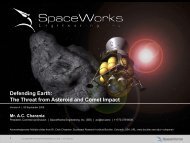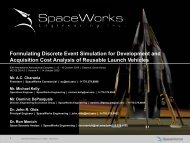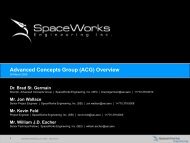Presentation - SpaceWorks Enterprises, Inc.
Presentation - SpaceWorks Enterprises, Inc.
Presentation - SpaceWorks Enterprises, Inc.
- No tags were found...
Create successful ePaper yourself
Turn your PDF publications into a flip-book with our unique Google optimized e-Paper software.
F I R M2Copyright 2009, <strong>SpaceWorks</strong> Engineering, <strong>Inc</strong>. (SEI) | www.sei.aero
FIRM AREAS OF ENGAGEMENT3<strong>SpaceWorks</strong> Engineering, <strong>Inc</strong>. (SEI) | www.sei.aero
SAMPLE CONCEPT STUDIES4<strong>SpaceWorks</strong> Engineering, <strong>Inc</strong>. (SEI) | www.sei.aero
SPACEWORKS SOFTWARE PRODUCT LINE5<strong>SpaceWorks</strong> Engineering, <strong>Inc</strong>. (SEI) | www.sei.aero
- Schaffer, M. G., Charania, A., Olds, J. R., "Evaluating the Effectiveness of Different NEOMitigation Options," AIAA-2007-P2-1, 2007 Planetary Defense Conference, Washington, D.C.,March 5-8, 2007.- Olds, J. R., Charania, A., Schaffer, M. G., "Multiple Mass Drivers as an Option for AsteroidDeflection Missions," AIAA-2007-S3-7, 2007 Planetary Defense Conference, Washington, D.C.,March 5-8, 2007.- Charania, A., Graham, M., Olds, J. R., "Rapid and Scalable Architecture Design for PlanetaryDefense," AIAA-2004-1453, 1st Planetary Defense Conference: Protecting Earth from Asteroids,Orange County, California, February 24-27, 2004.PREVIOUS PLANETARY DEFENSE WORK6<strong>SpaceWorks</strong> Engineering, <strong>Inc</strong>. (SEI) | www.sei.aero
The <strong>SpaceWorks</strong> Engineering / SpaceDev team thanks The Planetary Society (itsdirectors and its members and specifically Dr. Louis D. Friedman and Mr. BruceBetts) for the opportunity to present the Foresight design and increase publicawareness of the potential planetary threat from Near Earth Objects (NEOs) throughthe Apophis Mission Design Competition (Foresight: 1 st place overall). Special thanksare extended to Mr. Dan Gerachi for his leading financial support for this endeavor.THE PLANETARY SOCIETY’S APOPHIS MISSION DESIGN COMPETITION8Copyright 2009, <strong>SpaceWorks</strong> Engineering, <strong>Inc</strong>. (SEI) | www.sei.aero
- Foresight spacecraft is a small satellite mission design to orbit Near Earth Object(NEO) Apophis- Primary mission: reduce future orbital uncertainty of Apophis- Over a span of 300 days reduces the ±3σ error ellipse of Apophis' trajectory ("keyhole" or b-place encounter) in 2029 to 6.0 kilometers by 2017 (from 4500 km today)- Purpose-designed to meet minimum requirements of The Planetary Society’s 2007 ApophisMission Design Competition (1 st place overall international winner)- Characteristics- Small orbiter spacecraft with minimal instruments and complexity- Foresight’s Encounter Spacecraft (ES): 220 kg (wet mass), ~85 cm cube (stowed)- Total launch mass with Propulsive Transfer Vehicle (PTV): 1,608 kg (wet mass with payload)- Lean, low risk small satellite approach to design and manufacture- Foresight uses heritage components, instruments, and flight proven technologies- Proven mission approach with heritage from NEAR (Eros) and Hayabusa (Itokawa) missions- Low cost launch vehicle (Minotaur IV baseline, other options available)- Total life-cycle cost estimated to be under $131M USD (including launch)- Flexible- Multiple launch windows between 2012 and 2014 (extended mission option)OVERVIEW9Copyright 2009, <strong>SpaceWorks</strong> Engineering, <strong>Inc</strong>. (SEI) | www.sei.aero
M I S S I O N O V E R V I E W11Copyright 2009, <strong>SpaceWorks</strong> Engineering, <strong>Inc</strong>. (SEI) | www.sei.aero
There is a 600 mlong “keyhole”somewhere in thecurrent 4500 kmposition ellipse. IfApophis goesthrough this region ofspace during itsclose approach in2029, in 2036 it willhit the Earth.Note: not to scaleSources: "How Dangerous are Near-Earth Asteroids?," Clark R. Chapman, Southwest Research Institute Boulder, Colorado, USA, 2007 Space Weather Workshop Reception, After-Dinner Talk, UCAR Center Green Campus, Bldg. 1, 25 April 2007.CURRENT AND MISSION OUTPUT ERROR ELLIPSE FOR APOPHIS12Copyright ©2008, <strong>SpaceWorks</strong> Commercial, A Division of <strong>SpaceWorks</strong> Engineering, <strong>Inc</strong>. (SEI) All Rights Reserved
− Apophis, a 270 meter wide near-Earth asteroid, will pass within the range ofgeostationary satellites during its close approach to the Earth in April 2029− According to S. R. Chesley in 2005, the 2029 Apophis-Earth encounterdistance is predicted to be 5.89 Earth radii, ± 0.35 Earth radii, (3σ)− The 2029 close approach will significantly alter Apophis’ orbit− There is a small possibility that the asteroid will pass through an approximately 600 mwide area of space called a “keyhole”, which would cause Apophis to impact theEarth in 2036− More precise measurements of the orbit of Apophis can confirm or deny this possibility− Today, we have a 99.7% confidence (±3 sigma error) that in 2029 Apophis will bewithin a 4500 km window (with the 600 m “keyhole” somewhere in thiswindow)− Results in a 1 in 45,000 chance of Apophis impacting the Earth in 2036− After 300 days of orbiting Apophis, the Foresight mission will reduce the size ofthis window to approximately 6 km window (Goal in the Planetary SocietyCompetition was 14 km)− This will help determine whether Apophis will pass through the keyhole in 2029 andsubsequently impact the Earth when it comes back in 2036APOPHIS AND FORESIGHT13Copyright 2009, <strong>SpaceWorks</strong> Engineering, <strong>Inc</strong>. (SEI) | www.sei.aero
− Foresight spacecraft: concept design for radio tagging mission to Near Earth Asteroid (NEO)Apophis− Designed to meet requirements of 2007 Planetary Society Apophis Mission Design Competition)− Goal: Apophis tracking accuracy must be adequate to reduce the long dimension of the ±3σ errorellipse to 14 kilometers by 2017, for reference, this translates approximately to a 10% impactprobability if the keyhole is right in the middle of the 14-kilometer error ellipse.− Joint team design with <strong>SpaceWorks</strong> Engineering, <strong>Inc</strong>. (SEI) and SpaceDev, <strong>Inc</strong>.− Low-cost, low-risk, robust, minimal science mission to obtain accurate tracking information− Leverages off the shelf technologies, incorporating leaner approaches to spacecraftdesign− Launch on Orbital Sciences Corporation (OSC) Minotaur IV (Wallops Island, Virginia USA)− Five launch windows have been identified spanning years 2012 to 2014− Chemical propulsive transfer vehicle to perform outbound burn to Apophis (3,600 m/s) with Foresightencounter spacecraft performing portion of Earth departure, and Apophis capture burn (total lessthan 2,400 m/s)− Foresight spacecraft mass is 220 kg (propulsive transfer vehicle of 1,387 kg)− Foresight orbiting spacecraft powered by solar arrays augmented by rechargeable batteries (280.6 WEOL); transfer vehicle is powered by onboard batteries− The Spacecraft has two main instruments, a multi-spectral imager and laser altimeter− Over a span of 300 days reduces the ±3σ error ellipse of Apophis' trajectory ("keyhole"or b-place encounter) in 2029 to 6.0 kilometers by 2017− The total cost for this mission is estimated to be $130.9 M ($87.9 M for spacecraft and instrumentdevelopment and acquisition, $21 M for operations, and $22 M for the launch vehicle)− Overall system reliability is estimated to be 90.2%FORESIGHT MISSION OVERVIEW15Copyright 2009, <strong>SpaceWorks</strong> Engineering, <strong>Inc</strong>. (SEI) | www.sei.aero
FORESIGHT MISSION PROFILE16Copyright 2009, <strong>SpaceWorks</strong> Engineering, <strong>Inc</strong>. (SEI) | www.sei.aero
12,00011,00010,000LaunchWindow 1LaunchWindow 2LaunchWindow 3LaunchWindow 4LaunchWindow 59,0008,000Delta V [m/s]7,0006,0005,000Total Delta V Limit4,0003,0002,000Total Delta V1,000 Departure Delta VArrival Delta V01/2011 7/2011 1/2012 7/2012 1/2013 7/2013 1/2014 7/2014 1/2015Departure DateDeparture, Arrival, and Total Delta-V for Minimum Total Delta-V Trajectories from LEO to Apophis.LAUNCH WINDOW (1)17Copyright 2009, <strong>SpaceWorks</strong> Engineering, <strong>Inc</strong>. (SEI) | www.sei.aero
Minimum Total Delta-V Earth-Apophis TransferTrajectories for each Launch WindowMission Timeline for Primary Launch DateNo.Mission PhaseDate(initial)1. Launch 5/9/20122. Earth Departure: PTV Maneuver 5/9/20123. Stage Separation 5/9/20124. Commissioning 5/9/20125. Cruise 6/8/20126. Trailing Capture Maneuver 3/15/20137. Initial Survey 3/15/20138. Apophis Capture Maneuver 3/25/20139. Observation 3/25/201310. Apophis Withdraw Maneuver 4/24/201311. Tracking 4/24/201312. Extended Mission 2/18/2014FORESIGHT LAUNCH OPPORTUNITY AND TIMELINE19Copyright 2009, <strong>SpaceWorks</strong> Engineering, <strong>Inc</strong>. (SEI) | www.sei.aero
6,5006,000513 m/s176 m/s1,156 m/s192 m/s 515 m/s5,5005,0004,5001,851 m/s2,047 m/s 766 m/s2,144 m/s814 m/s1,231 m/sES RemainingES Arrival BurnES Departure BurnPTV ReservePTV Departure BurnDelta V [m/s4,0003,5003,000533 m/s 638 m/s224 m/s90 m/s 90 m/s90 m/s 90 m/s 90 m/s2,5002,0003,600 m/s3,600 m/s3,600 m/s3,600 m/s3,600 m/s1,5001,0005000Primary Alternate A Secondary Alternate B Alternate CLaunch Window20Spacecraft and Propulsive Transfer Vehicle (PTV) Delta-V Budget forOptimum Launch Dates within each Launch WindowFORESIGHT DELTA-V BUDGET:ENCOUNTER SPACECRAFT AND PROPULSIVE TRANSFER VEHICLECopyright 2009, <strong>SpaceWorks</strong> Engineering, <strong>Inc</strong>. (SEI) | www.sei.aero
2,5002,2502,000353 m/s100 m/s60 m/s16 m/s100 m/s60 m/s996 m/s32 m/s100 m/s60 m/s355 m/s100 m/s60 m/sReserveManeuveringStation-keepingArrival BurnDeparture Burn1,750814 m/sDelta V [m/s]1,5001,2501,851 m/s100 m/s60 m/s2,144 m/s1,0002,047 m/s 766 m/s7501,231 m/s500250533 m/s638 m/s0224 m/sPrimary Alternate A Secondary Alternate B Alternate CLaunch WindowEncounter Spacecraft Delta-V Budget for Optimum Launch Dates within each Launch WindowFORESIGHT DELTA-V BUDGET: ENCOUNTER SPACECRAFT21Copyright 2009, <strong>SpaceWorks</strong> Engineering, <strong>Inc</strong>. (SEI) | www.sei.aero
FORESIGHT SUN-EARTH ANGLES22Copyright 2009, <strong>SpaceWorks</strong> Engineering, <strong>Inc</strong>. (SEI) | www.sei.aero
− Internal software tools were developed by the Foresight team to accuratelypropagate Apophis’s orbit state and predict the uncertainty in Apophis’ state asa function of number of measurements and time between measurements− An 8th/9th order n-body numerical propagator with a variable step size was usedto propagate the actual and dispersed orbits of Apophis forward from a givenstate and epoch− The Sun, all of the planets and the Earth's moon are considered in the gravitationalmodel. The perturbing effects of the large asteroid-belt asteroids Ceres, Pallas, andVesta are also included. Solar pressure and the Yarkovsky effect are not modeled, buttheir associated uncertainties are addressed in the analysis− For a given starting condition, the propagator’s step-wise integration tolerances wereset so that results for position accuracies were on the order of a few meters in 2029Guess Initial State,X 0_pPropagate X 0_pSet New Initial State,X 0_pCalculate ObjectiveFunction, fRange Measurements,ρ measOptimizerNoConverged?YesX 0 = X 0_pORBIT DETERMINATION METHOD23Copyright 2009, <strong>SpaceWorks</strong> Engineering, <strong>Inc</strong>. (SEI) | www.sei.aero
1000Maximum 2029 Error Ellipse Dimension (km)100101300 Day Duration14 km Target0.14/21/2013 6/20/2013 8/19/2013 10/18/2013 12/17/2013 2/15/2014 4/16/2014DateApophis Error Ellipse Reduction for Target Mission (With Fine Monte Carlo)DECREASE IN ERROR ELLIPSE WITH OBSERVATION TIME24Copyright 2009, <strong>SpaceWorks</strong> Engineering, <strong>Inc</strong>. (SEI) | www.sei.aero
ζ-axis Position (Earth radii)2InitialAfter Mission1Earth0-12 -11 -10 -9 -8 -7 -6 -5 -4 -3 -2 -1 0 1 2-1-7.49000Location Probability+/- 3σ = 6 km-7.49500-7.50000-7.50500ζ-axis Position (Earth radii)-7.51000-7.51500-7.52000-7.52500-7.53000-2-3-4-5-6-7.53500-7.54000-1.50500 -1.50000 -1.49500 -1.49000 -1.48500ξ-axis Position (Earth radii)ξ-axis Position (Earth radii)-7-8Initial and Final Position Error in 2029 after 300 Days of Tracking (B-Plane Error Ellipse Comparison)(Assuming no Additional Earth Observations after 2012)FORESIGHT MISSION: EFFECT ON OVERALL ERROR ELLIPSE25Copyright 2009, <strong>SpaceWorks</strong> Engineering, <strong>Inc</strong>. (SEI) | www.sei.aero
S P A C E C R A F TO V E R V I E W26Copyright 2009, <strong>SpaceWorks</strong> Engineering, <strong>Inc</strong>. (SEI) | www.sei.aero
27Copyright 2009, <strong>SpaceWorks</strong> Engineering, <strong>Inc</strong>. (SEI) | www.sei.aero
FORESIGHT ENCOUNTER SPACECRAFT (ES)28Copyright 2009, <strong>SpaceWorks</strong> Engineering, <strong>Inc</strong>. (SEI) | www.sei.aero
Component Name ManufacturerPropulsionNo.on ESLocation ProbabilityFORESIGHT SUBSYSTEM COMPONENT SPECIFICATIONSNo. onPTVSpecificationsS/C Main Engine 22 Aerojet 445 Aerojet 1 0 Thrust (vac): 445 N, Isp: 309 s, T/W: 24.39S/C RCS 23 Aerojet 2 Aerojet 6 0 Thrust (vac): 2 N, Isp: 265 s, T/W: 0.75PTV Main Engine 24 R-40B Aerojet 0 1 Thrust (vac): 4000 N, Isp: 293 s, T/W: 56.4Thrust (vac): 21 N, Isp: 285 s, T/W: 3.81, QuadPTV RCS 25 Aerojet 21 Aerojet 0 4 configurationThermal ControlHeaters 26PowerKaptonHeaters Minco 16 0 -200 to 200ºC range, Kapton/FEP materialBatteries 21 VES 180 Saft 6 2Solar Array 22TripleJunction Spectrolab 2 0Distribution PDU SpaceDev 1 1Command and Data HandlingCPU 27PowerPC750 FX IBM 1 0Memory 28 16 GB SSD Samsung 2 0SCC 29 8051 Silicon Labs 0 1Attitude Determination and ControlLi-Ion space technology, specific energy: 165Wh/kg, storage: 180 Wh eachGaInP2/GaAs/Ge, BOL power: 289 W/m2, BOLefficiency: 22.5%, EOL power: 256 W/m2, 4%degradation per year16 5-Amp high side relays, Integrated 200-W Li-Ion battery charger, 96 12-bit ADCs, Digital solararray peak power trackingRISC Microprocessor, 1856 MIPS at 800 MHzwith 256 MB RAM, RS-422 / USB / EthernetcompatibleNAND-based SSD, read rate: 57 MBps, writerate: 32 MBps1000 MIPS @ 100 MHz, 128 KB Flash, 8448bytes data RAM, 8 12-bot ADCs, 2 12-bit DACsSun Sensor 30 MSS AeroAstro 12 0 60º FOV, accuracy ±1ºStar Tracker 31 HE-5AS Terma 2 022º FOV,
MASS BREAKDOWN STATEMENT:ENCOUNTER SPACECRAFT (ES)No.NameElement Mass Subsystem Mass[kg][kg]1.0 Structures and Mechanisms 26.0Primary Structure 14.8Secondary Structure 5.5Fuel Tank 2.3Oxidizer Tank 2.3Pressurant Tank 0.7Solar Array Support Structure 0.2Solar Array Actuators 0.22.0 Propulsion 7.0Main Engine: Aerojet 445 1.9Main Engine Feed Lines 1.9Maneuvering Engines: Aerojet 2 (x6) 1.6Maneuvering Engine Feed Lines 1.63.0 Thermal Control 5.0Reflective Foil 1.0Multi-Layer Insulation 3.8Heaters 0.24.0 Power 12.1Batteries: Saft VES 180 (x6) 6.7Solar Array: Spectrolab Triple Junction 2.1Power Distribution Unit 1.7Power Cabling 1.65.0 Command and Data Handling 4.9CPU: PowerPC 750FX 0.1Memory: Samsung 64 GB Solid State Drive (x2) 0.1Electronics Module 1.0Wiring 3.76.0 Attitude Determination and Control 12.9Sun Sensors: AeroAstro MSS (x6) 0.4Star Sensors: Terma HE-5AS (x2) 4.4Reaction Wheels: Dynacon MicroWheel 1000 (x4) 6.6Inertial Measurement Unit: LN-200S 1.57.0 Communications 8.9High Gain Antenna 3.0Low Gain Antenna (x2) 0.7Small Deep Space Transponder 2.9Multi-Mode S-Band Transceiver 2.38.0 Margin (20%) 13.69.0 Dry Mass 90.210.0 Consumables 120.1Fuel: MMH 45.1Oxidizer: NTO 74.4Pressurant: He 0.711.0 Wet Mass 210.312.0 Payload 10.0Advanced Imagery Mechanism (AIM) 5.0Laser Altimeter Device (LAD) 5.013.0 Gross Mass 220.3Location ProbabilityNo.Element NameMass[kg]1.0 Structures and Mechanisms 26.02.0 Propulsion 7.03.0 Thermal Control 5.04.0 Power 12.15.0 Command and Data Handling 4.96.0 Attitude Determination and Control 12.97.0 Communications 8.98.0 Margin (20%) 13.69.0 Dry Mass 90.210.0 Consumables 120.111.0 Wet Mass 210.312.0 Payload 10.013.0 Gross Mass 220.3MASS STATEMENT: FORESIGHT ENCOUNTER SPACECRAFT (ES)30Copyright 2009, <strong>SpaceWorks</strong> Engineering, <strong>Inc</strong>. (SEI) | www.sei.aero
MASS BREAKDOWN STATEMENT:PROPULSIVE TRANSFER VEHICLE (PTV)No.NameElement Mass Subsystem Mass[kg][kg]1.0 Structures 133.6Primary Structure 18.8Secondary Structure 13.9Payload Adapter 5.5Fuel Tank 22.5Oxidizer Tank 22.7Pressurant Tank 50.22.0 Propulsion 31.8Main Engine: Aerojet R-40B 6.8Main Engine Feed Lines 6.8RCS Engines: Aerojet 21 (x16) 9.1RCS Engine Feed Lines 9.13.0 Thermal Control 12.1Reflective Foil 2.4Multi-Layer Insulation 9.74.0 Power 6.2Batteries: Saft VES 180 (x2) 2.2Power Distribution Unit 0.9Wiring 3.15.0 Command and Data Handling 1.6Spacecraft Control Computer 0.1Electronics Module 1.0Wiring 0.56.0 Attitude Determination and Control 1.5Inertial Measurement Unit: LN-200S 1.57.0 Margin (20%) 37.48.0 Dry Mass 224.29.0 Consumables 1,163.1Fuel: MMH 426.1Fuel Reserves / Residuals 10.5Oxidizer: NTO 702.7Oxidizer Reserves / Residuals 17.3Pressurant: He 6.510.0 Wet Mass 1,387.311.0 Payload 220.3Foresight Spacecraft 220.312.0 Gross Mass 1,607.6Location ProbabilityNo.Element NameMass[kg]1.0 Structures 133.62.0 Propulsion 31.83.0 Thermal Control 12.14.0 Power 6.25.0 Command and Data Handling 1.66.0 Attitude Determination and Control 1.57.0 Margin (20%) 37.48.0 Dry Mass 224.29.0 Consumables 1,163.110.0 Wet Mass 1,387.311.0 Payload 220.312.0 Gross Mass 1,607.6MASS STATEMENT: PROPULSIVE TRANSFER VEHICLE (PTV)31Copyright 2009, <strong>SpaceWorks</strong> Engineering, <strong>Inc</strong>. (SEI) | www.sei.aero
FORESIGHT ENCOUNTER SPACECRAFT (ES) CONFIGURATION32Copyright 2009, <strong>SpaceWorks</strong> Engineering, <strong>Inc</strong>. (SEI) | www.sei.aero
549 cm462 cm309 cm205 cmForesight Encounter Spacecraft and PTV inMinotaur IV Payload FairingForesight Encounter Spacecraft and PTVFORESIGHT SPACECRAFT DIMENSIONS AND LAUNCH VEHICLE PACKAGING33Copyright 2009, <strong>SpaceWorks</strong> Engineering, <strong>Inc</strong>. (SEI) | www.sei.aero
Life Cycle Cost StatementCost Element NameDDT&E[$US FY2007]Acquisition Cost[$US FY2007]Total Cost[$US FY2007]Spacecraft Stages $57.85 M $23.74 M $81.59 MForesight Encounter Spacecraft $23.51 M $14.77 M $38.28 MPropulsive Transfer Vehicle $34.34 M $9.27 M $43.61 MScientific Instruments (2) -----Location Probability$6.30 M $6.30 MOperations ----- $20.99 M $20.99 MLaunch Vehicle: Minotaur IV ----- $22.00 M $22.00 MTotal $57.85 M $73.03 M $130.88 M25020090th: 89.4 %Mean: 90.2 %Frequency150100LOM5.2%0.8%3.2%0.5%Launch VehiclePropulsive Transfer Vehicle (PTV)Encounter Spacecraft (ES)Instruments500% 2% 4% 6% 8% 10% 12%088.6% 89.0% 89.3% 89.6% 90.0% 90.3% 90.6% 90.9% 91.3% 91.6%Contribution of Architecture Elements (%)Probability of Mission Success (%)Histogram of Reliability Results(20,000 Monte Carlo Trials)Contribution of Architecture Elements toLoss of Mission (LOM)COST AND RELIABILITY34Copyright 2009, <strong>SpaceWorks</strong> Engineering, <strong>Inc</strong>. (SEI) | www.sei.aero
− Potential future analysis− Refinement of baseline concept (alternative tank designs, ∆V split, etc.)− Update to Apophis knowledge since initial design− Analysis of alternative instrument suite− Alternative target− Integration with Sierra Nevada Corporation (SNC) low cost bus approaches− Examine commonalties and alternatives for NASA Ames common modular bus− Potential small satellite technology advancement (funding: NASA SBIR/STTR, etc.)− Other thoughts− ESPA ring designs may offer potential cost savings for asteroid missions, but scheduleand launch integration issues may affect overall benefits− Transponder missions do not have to be technology demonstration missions− Potential leveraging of multiple funding sources (multiple end users, the U.S. –DoD/NASA/DHS) for actual mission− Consider use of Falcon 1e: 1,010 kg to LEO for $11.27 M (FY2009, Q4)− LEO: 185 km circular orbit launched due east (9.1 deg)− 2009 IAA Planetary Defense Conference White Paper Notes− Planetary defense is multilayered response− Low cost non-science focused reconnaissance missions are one part of an overallresponse strategy (multiple types of missions: transponder, thermal IR, etc.)− Potential need to prioritize order of data required for reconnaissance missions (radioscience before thermal IR for instance or in what combination)− Leverage existing global small satellite community (already in progress in variousways)FORWARD WORK AND THOUGHTS35Copyright 2009, <strong>SpaceWorks</strong> Engineering, <strong>Inc</strong>. (SEI) | www.sei.aero
Business Address:<strong>SpaceWorks</strong> Engineering, <strong>Inc</strong>. (SEI)1200 Ashwood Parkway, Suite 506, Atlanta, GA 30338 U.S.A.Phone: 1+770.379.8000 | Fax: 1+770.379.8001 | www.sei.aero | info@sei.aerow w w . s e i . a e r o36Copyright 2009, <strong>SpaceWorks</strong> Engineering, <strong>Inc</strong>. (SEI) | www.sei.aero








